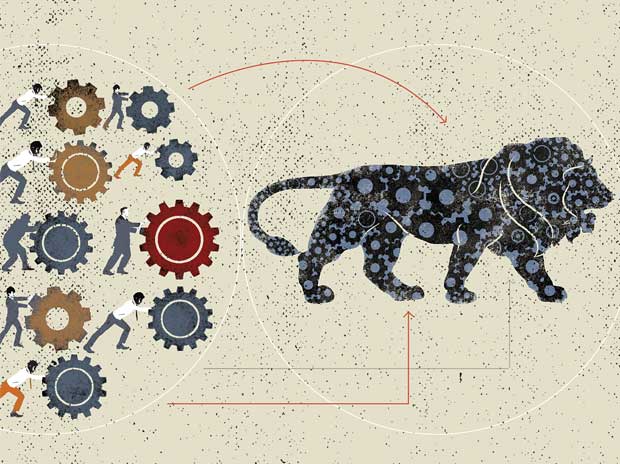Post-COVID Paradigm Shifts
Never before has mankind experienced disruptions as unprecedented as it is facing under the disparaging cloud of COVID-19 pandemic which has enveloped the entire world. While major shifts are taking place individually at the micro level, there is an underlying uncertainty and threat surrounding the world economy at the macro level, which brings back memories of The Great Depression and the 2008 Financial Crisis. China being the epicentre of the pandemic has led to a deadlock situation as the country has been the central hub in global supply chains, especially in major industries such as pharmaceutical, automobile, electronics, aviation, medical equipment etc. It has also been a manufacturing-giant and created a global dependency on its goods. This dominant role played by China as the centre of global value chains has led to losses worth $50 billion in global exports. It is being predicted that the world economy will start repairing itself from the COVID-19 after-effects after about two quarters, given the ‘self-healing’ nature of the 21st century world economy with competent monetary and fiscal policies and integrated markets. However, China is likely to be the worst hit due to an emerging trust-deficit towards the country and the post-COVID-19 world has prospects for new contenders to play China’s role in global supply chain and do it better.
Silver Lining for India
India is at the forefront of leveraging this opportunity due to its geographically favourable location along the global supply chain akin to China’s coupled with its range of unique strengths and capabilities. The country’s readily available land and labour clubbed with robust economic policies and mutually beneficial foreign policy has the potential to attract global investors looking to diversify their supply chains and move out of China. To quote Prime Minister Narendra Modi: “India has the right blend of the physical and the virtual” and “can emerge as the global nerve centre of complex modern multinational supply chains in the post COVID-19 world.” A key pull-factor for manufacturing firms seeking alternative destinations is local supply chain capacities, which are already being built across India. Moreover, substantially low cost of labour, incentives and flexibility to work with regulatory relaxations for manufacturing add to India’s attractiveness for global brands.
Another significant change in the India economic sphere has been the recent reduction in the corporate tax rate for manufacturing firms from 25 percent to 15 percent, amounting to an effective tax rate at around 17 percent including cess and surcharge. India now competes with ASEAN’s developing economies like Indonesia, Vietnam and Thailand for foreign investment efficiently. However, India has a comparative advantage over these countries owing to its larger market and relatively lower cost of production and prompt availability of labour.
Aside from the strategic advantages that India has in its kitty, there are also some challenges and their corresponding areas of improvement in line for the country. Factories in India at large lack world-class environment and safety standards and basic code of conduct on labour. Labour laws in the country are also not compatible with International Labour Organisation (ILO). This often creates a roadblock for foreign investors who are used to a standardized way of operating and are strict about these protocols, which is only likely to gain more emphasis in the post-COVID world. Therefore, elaborate structural reforms are a must with a focus on improving safety and factory infrastructure along with implementing reforms for labour flexibility and safeguarding health and grieving mechanisms for the work force, in order to attract new and retain existing foreign investors. Legal reforms for faster land acquisition and leasing are also urgently required to urge international companies to set up units in the country without going through a prolonged gestation period.
Rising to the Occasion in Post-COVID World
Economic growth in India thus far has primarily been driven by the services sector and the country had completely missed out on manufacturing and export-driven growth. Therefore, while the corona virus outbreak has distressed world economy, it is also being seen as a second opportunity for countries like India to bring about the Fourth Industrial Revolution. The incumbent government has been promoting ‘Make in India’ for a while now which is now expected to gain even more emphasis as the need to strengthen local capabilities has arisen. India will need to further relax its protectionist policies and provide foreign companies a level-playing field by reducing tariffs and implementing more welcoming policies to foster reliable supply chains relationships in the post-COVID world. The country will further need to update technologies in factories and work places to facilitate a new way of life with safety at the forefront and pervasive remote working. The artificial intelligence industry, drones and robotics would soon witness a major boom as human contact reduces and dependency on machines increases. This transition into the ‘digital age’ could be driven by India’s IT expertise and young talent. In the Indian context, the increase in work-from-home opportunities is also likely to lead to a far greater participation from people, especially some women who otherwise could not work due to various reasons like household responsibilities etc., contributing to a productive and larger work force.
Encouraging public-private partnership in upcoming areas like research and development of medical equipment, vaccines and drugs as well as adversely affected industries like aviation, hospitality etc. will also make India a favourable and trust-worthy destination for foreign investors. There are also massive opportunities for India to build relevant infrastructure, assembly units, enhance digital connectivity and ensure that it is all done well in time as speed is the need of the hour during this redistribution of multinational supply chains and decreasing dependence on China. ‘First mover’s advantage’ is crucial in this corona crisis and what seems as an economic catastrophe might just become a blessing in disguise for an already ailing Indian economy if the country plays its cards strategically.









